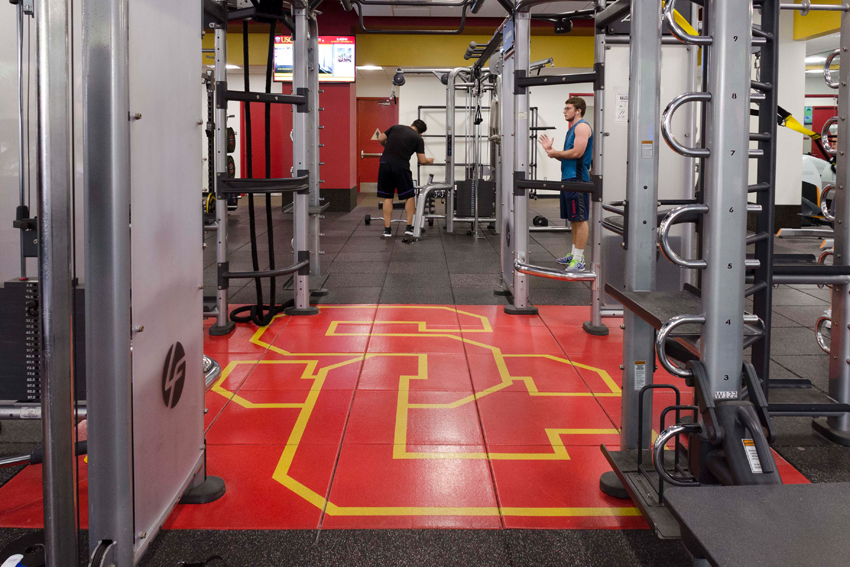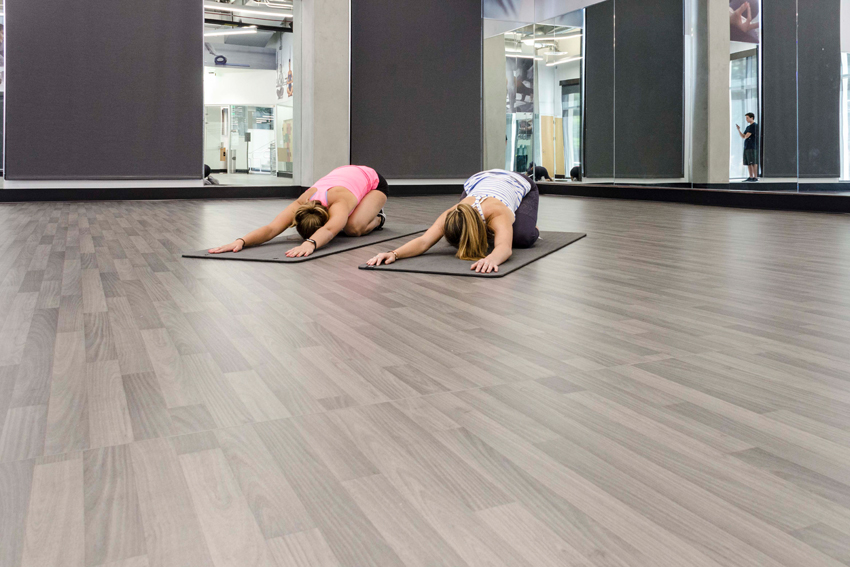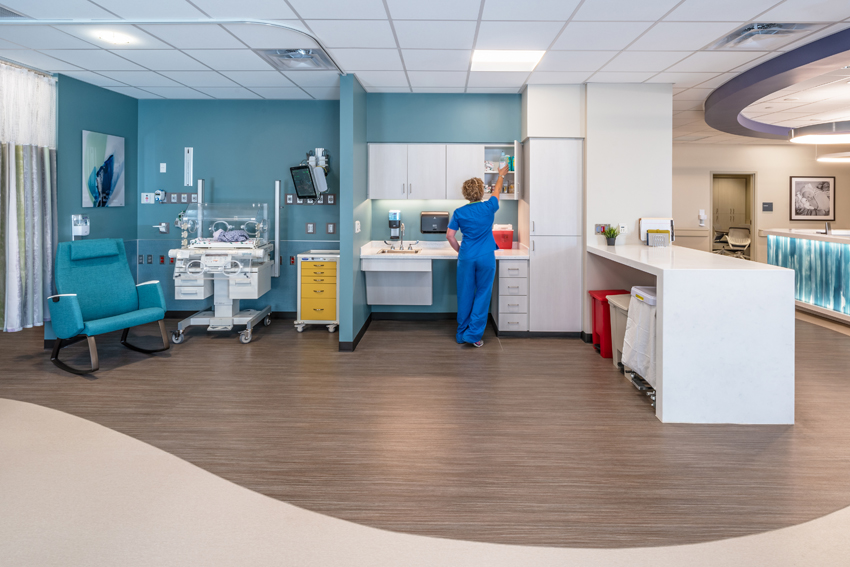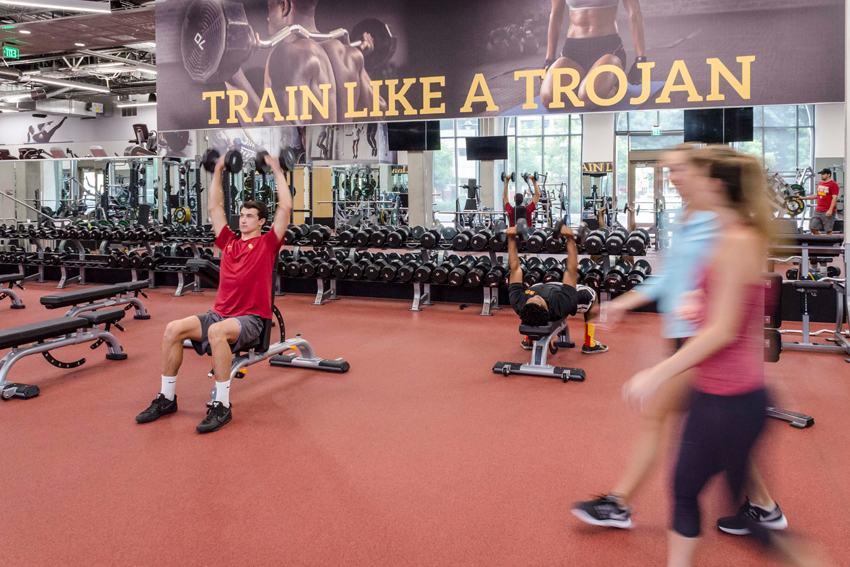Secondhand Noise: Can Flooring Solve the Problem?
USC Village Fitness Center’s New Acoustic Flooring Solution
Controlling noise at the source was the strategy used by designers of the new USC Village Fitness Center, which nearly doubled the total indoor recreational space available to the Trojans. The new state-of-the-art fitness center is part of a sprawling addition to the Los Angeles university that extends across 15 acres and is part of the school’s efforts to expand student housing and increase academic space.
The 30,000-square-foot fitness center features numerous fitness and wellness options for students. A key component of the upgrade was the addition of innovative flooring to improve ergonomics and safety for students and reduce noise between the facility and the resident floors above it.
“Noise reduction was a major component of this project,” says Justine Gilman, senior director, USC Recreational Sports. “We sought durable flooring that would reduce noise in the free weight and cardio equipment areas, especially with students living right above the fitness center.”

With student housing above, the University of Southeren California's new Village Fitness Center needed to provide sound control at the source with performance flooring.
To meet flooring specifications, Gilman and the design team selected various flooring products with acoustical benefits for installation in various areas of the facility. For the cardio and functional training areas, Gilman selected an engineered performance flooring product that is 14.5 millimeters thick, combining a 2.5-millimeter wear layer with a 12-millimeter shock-absorbing base layer, which is engineered to absorb the impact force related to aggressive functional training. A strip of engineered turf next to the cardio and functional training area features a dense, textured nylon wear layer fusion bonded to a 12-millimeter performance backing. It is ideal for footwork drills, sled work, and tire flips.
The free weights, plate-loaded machines, squat racks, and Olympic lifting area of the facility were outfitted with an engineered surface featuring a 2.5-millimeter performance layer fusion bonded to a 10-millimeter dense vulcanized composition rubber backing that is then field united to a 12-millimeter shock-absorbing rubber pad. Also, a synthetic wood-grain engineered surface that is fusion bonded to a 5-millimeter performance base layer was specified in the group exercise rooms.
“We are very pleased with the functionality of the floors,” Gilman says. “We have received numerous compliments about the design of the Village Fitness Center space, and the flooring has definitely contributed to the overall positive experience.”
Specifying Flooring to Reduce Noise and Affect the Bottom Line
A flooring specification to reduce noise and impact energy is a lasting intervention that will perform in all situations. This is unlike an administrative control, such as instituting quiet hours, that can wane over time. Flooring can also affect the bottom line as buildings perform better, adjacent occupants complain less, and occupants move less often.
Consider the implications in the following settings where flooring lessens sound and impact transmission.
Apartments
When sound-reducing and impact-absorbing flooring is installed in multifamily housing, occupants will be less aggravated from hearing footfall and noise from adjacent units. The occupants may never know the superior flooring contributes to their health and sense of well-being; but they may stay longer in the unit, thus reducing the turnover that is so costly to landlords.

The design team selected an engineered performance flooring product that is 14.5 millimeters thick, combining a 2.5-millimeter wear layer with a 12-millimeter shock-absorbing base layer.
Hotels
For most of us, the mark of a quality hotel is a quiet environment with no sound whatsoever emanating from neighboring rooms. When sound is blocked and absorbed at the source, it equates to improved guest satisfaction from less neighbor noise.
Hospitals
A peaceful, quieter hospital setting is enormously significant when patient healing and staff health are considered. Less noise helps the hospital fulfill its reason for existing, to help patients get better. Less noise can also have a financial impact, as improved HCAHPS scores can mean higher reimbursements from the CMS.

Dissatisfaction with noise can create financial problems for hospitals, gymnasiums, multifamily housing, and other applications.
Fitness Facilities
With fitness facilities, the stakes are higher than just annoying the neighbors. In some cases, the impacts and sounds coming from a gym are so egregious that legal action is taken or the facility has to move. There are good reasons why fitness centers and gyms are seen so often in industrial areas. The noise and impacts may be too disruptive for adjacent neighbors in residential or business locations. Moving a gym is costly and disruptive. When sound-reducing and impact-absorbing flooring is specified in fitness centers that cannot be separated from adjacent properties, disruption to neighbors is decreased.
Material Properties of Flooring that Reduce Noise
When a falling weight hits a hard floor, it slows down rapidly. The more quickly the weight slows down, the higher the maximum force the weight and floor experience. If the time for the weight to slow down is increased, the maximum force that it and the floor experience is reduced. This is why airbags and crumple zones in cars exist, why rock climbers use crash pads, why there is foam in our running shoes, and why thick rubber surfaces are placed on playgrounds.
This is the goal of performance fitness flooring: to increase the amount of time it takes for a falling weight to slow down. Generally speaking, the more “squish” something has, the longer that “slowdown” time is. Think about the difference between someone falling onto a carpet floor, a foam mattress, or a pit full of soft foam blocks.
This has all focused on the force on the falling object. But if we reduce the force on the falling object, we also reduce the force on the thing it hits. Generally, the harder something is hit, the more noise it makes. Pounding on a desk is ample demonstration. When floors are designed to reduce impact noise, they are designed to reduce the maximum impact force.
A giant pit of foam blocks would dramatically reduce impact noise, but it would not be a great surface to work out on. When flooring is selected to reduce impact noise, how it will be used must be considered to find the right balance between force reduction and stability. As an analogy, a sports car like a Lamborghini has a stiff suspension that allows it to go around corners extremely fast, but it could be miserable to drive on a bumpy road. On the other hand, the softer suspension on a Lexus sedan allows it to float over bumps but hampers its ability to go fast around turns.
When a flooring surface is designed to reduce the impact force, and thus the amount of impact noise, there are several basic parameters that we can control to affect the performance. They are stiffness, thickness, and shape. All three are related and can affect each other. To look at the interplay between them, consider the following example.
Stiffness, Thickness, and Shape
To reduce impact noise from a falling weight, we need a soft floor, so let us start with a common soft flooring: a typical residential carpet and pad. A carpet and pad feel soft, and they generally do a good job of reducing noise from smaller impacts like footsteps. However, when the floor is hit harder, such as when a dumbbell is dropped on it, the carpet and pad are quickly and fully compressed, or squished, and the weight comes to an abrupt stop.
To keep the floor from bottoming out, a stiffer floor of a similar thickness can be used. This reduces the chances of the weight bottoming out, but there is still a limited distance over which the weight can slow down, so the ability to reduce the impact force, and thus impact noise, is limited.
To provide for a longer “slowdown,” the thickness can be increased. Think of the difference between falling on a thin foam mattress topper and a thick foam mattress. With the thin foam pad, the slowdown is quick, but with the foam mattress, the slowdown is gentler. A thick foam mattress can significantly reduce the impact force and noise, but it is too soft to be used as a floor surface, and it is soft enough that heavier weights might still cause it to bottom out.
This is why stiffer and thicker flooring is needed, such as rubber fitness flooring. Rubber flooring provides a wide range of thicknesses, and the stiffness can change based on its density, or how much rubber is packed in the same space. Sometimes though, just changing the density will not reduce the stiffness as much as is needed. This is where shape comes into play.
If a floor cannot be made soft enough just by reducing the density, some of the material can be removed to change the shape. This is why rubber fitness tiles have a solid top surface but individual feet underneath instead of them being solid all the way through. The space between the feet gives the rubber more room to squish, which further reduces the impact force.
By varying these parameters, stiffness, thickness, and shape, flooring can be created that provides a good balance between stability and force/noise reduction. Each manufacturer of flooring with acoustical benefits can recommend the best product for the application based on its products’ properties.

Flooring with acoustical performance is a precise combination of material properties.









